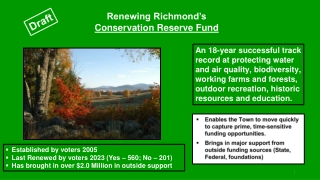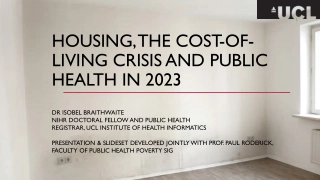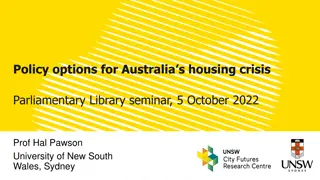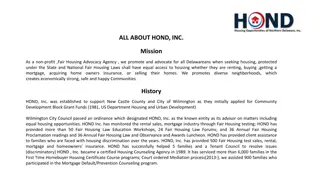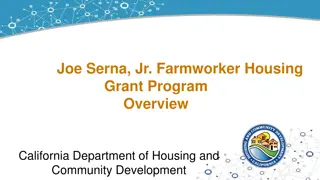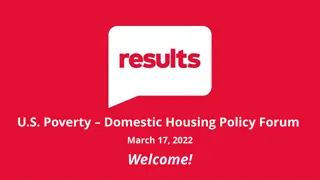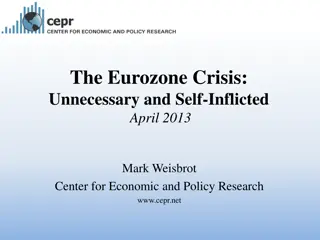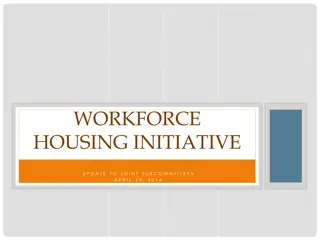Addressing Richmond's Housing Crisis: A Call to Action
Amid an intensifying housing crisis, Richmond's RPA Housing Action Team is convening to discuss strategies in response to the lack of affordable housing. The session aims to provide updates on regional efforts, engage with nonprofit developers, and set clear housing goals. Key data highlights the pressing need for more housing units, especially affordable ones. The session acknowledges the regional nature of the issue, emphasizing the collective responsibility in finding solutions to the housing shortage.
Download Presentation

Please find below an Image/Link to download the presentation.
The content on the website is provided AS IS for your information and personal use only. It may not be sold, licensed, or shared on other websites without obtaining consent from the author. Download presentation by click this link. If you encounter any issues during the download, it is possible that the publisher has removed the file from their server.
E N D
Presentation Transcript
Thinking Big about Richmonds RPA Housing Action Team City Council Study Session Housing Goals
Purpose of the Session To paint an optimistic picture about our opportunities To provide a partial update on the changing landscape how the housing crisis is being discussed and addressed at the State, Bay Area and county levels What actions are being taken To facilitate a discussion with a non-profit developer that specializes in affordable rental housing To request a process whereby we decide our housing goals and adopt strategies for success Find a way to answer the eight questions we pose
The Housing Crisis continues to intensify The Bay Area hasn t been building enough housing to keep up with population growth for over three decades and Over the last decade, three quarters of housing projects in the region were for households with above moderate income In contrast to the major investments in freeways and other infrastructure that supported suburban development in previous decades, today s more focused growth receives limited support, due in large part to the dissolution of redevelopment agencies, exhaustion of several one-time State bond financed programs, and the precipitous decline of federal housing ABAG White Paper on Displacement, August 2015
Its a Regional Problem Between 2010 and 2016, the Bay Area added 500,000 Jobs but only 50,000 Homes It s a regional problem and we need regional solutions - John Gioia This means everyone in the Bay Area is a potential ally if you can really help solve the problem!
The Bottom Line on the need Per ABAG, 700,000 new units in the Bay Area by 2040 with 50% affordable (subsidized) Per the California Department of Housing and Community Development, 180,000 new units per year state-wide to keep up with population growth Per Senator Scott Wiener, current shortfall is 4 million homes state-wide
Contra Costas situation is among the worst Overcrowding is 43% above the national average Between 2000 and 2016, the County s poor population grew by 33%, led by big increases in Concord, Antioch & Pittsburgh overall population grew by 20% A lot of the job growth has been in jobs paying $20-40K The California Housing Partnership identified a current shortfall of 30-35K affordable rental units for people making less than 50% of AMI The current total shortfall of affordable rental housing is well over 40,000 units And our population is expected to increase by 26% over the next 22 years We have trouble competing for State housing subsidies when our local contribution on projects is less than what other counties make possible
1) The State of California is in Motion 2017 Accomplishments 15 housing bills passed including Cap & Trade Funds - $1.5 bil set aside for CARE communities like Richmond (not only for affordable housing) SB 2 Will generate $250 mil/yr for affordable housing from filing fees SB 3 places a $4 bil housing bond on Nov 2018 ballot SB 35, 73 and 140 streamline approval processes, financial support for local planning
And the momentum continues to build 2018 Bills under discussion now: SB 912 - $2 bil from the general fund s surplus for affordable housing AB 2562 - $500 mil low interest loan funds to replace federal funds lost AB 2065 - encourages use of surplus public land for affordable housing (15% affordable) AB 2923 - support construction of 20,000 units at or near BART stations (20% affordable) AB 3152 - property tax relief for affordable rental housing AB 2162 - fast track approvals for supportive housing for the homeless SB 827 - high density up-zoning on transit corridors = standardizing zoning, relocation & affordability guidelines (20% avg requirement) SB 828 - compels all cities and counties to increase high density zoning & supply
2) San Franciscos housing program Initial goal set as 30,000 units over 7 years (2014-2020) with 30% permanently affordable 3,000 units/yr market rate & 1,300 units/yr affordable (mix of VL, L & M) Actual unit completion was 5,100 per year in first 41 months with 37% permanently affordable (1,887 per year affordable ) In sum, San Francisco has a comprehensive plan to spend $3-4 billion on affordable housing over 25 years and $1.5-$2 bil on transportation improvements for neighborhood build-out support (see Appendix) Big numbers are possible! San Francisco has more resources and can act faster than everyone else, but the State, Region & our County also have goals to meet!
3) The Contra Costa Ensuring Opportunity Campaign A County-wide Coalition is being built to address poverty and homelessness, with affordable housing as a top priority Over 150 people attended the Housing Summit on 3/26/18 Circulating new ways of thinking about solutions, partnerships, best practices and new paths to greater efficiency & effectiveness A big push to think about scale, innovative solutions and cooperation Aiming to put an affordable housing measure on the ballot (bond or sales tax increase) in November 2020 John Gioia and Candace Anderson sponsoring the drive Will Richmond provide energy and leadership?
New models for planning and acting! Did you know? 35% of Single Family Homes in Vancouver, BC have ADUs - It s not easy, but it s also not impossible! - At least 500 homeowners in Richmond?
New ways of thinking I m not so concerned about fairness splits. I want to work with communities that want to develop housing. Kara Douglas Assistant Deputy Director, CCC Dept of Conservation & Development (Director of Affordable Housing Programs)
But you have to accept the economics Averages are tricky, but it costs around $480,000 to build a unit of multi- family housing today. Certain types of construction & rehab can be lower Need to find ways to bend the cost curve down to $425K Projects need subsidies, sometimes as much as $150K/unit Developers need access to low cost financing
Eight Key Questions Community Opinion Strategies Topics Next Steps Appendix: Best Practices
Is it possible to sell Richmond to the State, Region & County as a city of special potential for addressing the Bay Area housing crisis? What are the keys to success? Can Richmond shoot for 30,000 - 40,000 units over 25 years? Could 50-60% be affordable to people making 100% or less of County AMI? (In 2017 dollars, income of $75K, a rent < $1,875/mo or purchase < $300,000) How much should be for people making 80% or less of AMI? Eight Key Questions What are the public transportation solutions, school construction and infrastructure improvements required? How can we accelerate the build-out of the Macdonald Ave corridor, the South Shore and San Pablo Ave? What about 23rd St? What do we need to do to identify, prioritize and facilitate the assembly of sites for development?
For the affordable units, what percentage should be rental units vs. home ownership opportunities? Should 20,000 affordable units = 16,000 rental & 4,000 purchase? Do we want most affordable units to be in mixed developments? What are the goals for unit size mix? Given the likely passage of State and County Affordable Housing bonds, the targeting of Cap and Trade funds to housing in communities like Richmond plus other State sources, how much could we hope to capture if the County is on our side? Are the subsidies needed for the first 5,000 units already in sight? Eight Key Questions What does it look like to work effectively with non-profit housing developers? How many should we try to work with? How can we attract more of them to Richmond? What is the real solution to the Abandoned Housing problem? Progress is very slow! What must change? Do any other cities in the County have the same problem with zombie properties?
ABAGs goal of 700,000 new units by 2040 - with 50% affordable There aren t many cities in the Bay Area able to contribute 5% of the total And fewer happy to build 5% of the affordable goal Can Richmond dare to think We are 12% larger than San Francisco probably 50% larger counting North Richmond. We can fit 30-40,000 units of housing We have more vacant land and abandoned or underutilized properties with low market values - creating a significant cost advantage on site assembly big? Our zoning regulations & permitting processes are ready to go except for finalizing our inclusionary housing regulations and fees Richmond Build is an attractive selling point We are 30 min from SF and 20 min from Oakland by BART
Cities in the Inner Bay Area Counties > 100,000 San Jose San Francisco Oakland Fremont Hayward Sunnyvale Concord Santa Clara Berkeley Antioch Richmond Daly City San Mateo Half of the Bay Area s population lives in these 13 cities If half of the new housing we need was built in these cities, the average would be 27,000 If 75% was built, the average would be 40,000
Community Opinion Many community groups in Richmond think building affordable housing should be a top priority Affordable housing was a major issue across the Bay Area during the 2016 election Rent control and strengthened tenant protections were on the ballot in ten communities Major funding measures were passed in Alameda, Santa Clara & San Mateo counties We need subsidized rental units aimed at households making 20- 100% of County AMI And subsidized home ownership opportunities for working class families ready for that step
316 Terminal 1 289 Nevin Homes (Affordable) 193 Bay Walk 180 Hilltop 98 Garrity Way, Hilltop 80 Miraflores senior (Affordable) Projects in Richmond s pipeline 190 Miraflores family (Affordable) 60 Shea Bottoms 27 The Point 88 Anchorage, Marina Bay 193 Quarry, Canal Blvd. 267 12th and Macdonald (Mixed, developer proposing up to 400) Total Units most not built yet, approximately 1/3rdaffordable 1981 About 260 units/year over 8 years
Stop worrying so much about attracting high end developers They are very cautious about Richmond because upper middle class projects here can t command the selling prices needed to make normal returns It s a struggle for them to sell an average sized condo for $900K Assuming a few projects in the South Shore area, we might get to 3,000 high end units on the shoreline Work hard to facilitate the construction of 1,500 units per year: 15,000 housing units at Hilltop and the South Shore 15,000 housing units in the Macdonald corridor, 23rd St and on San Pablo Ave 5,000 units from in-fill sites all over town, Point Molate, North Richmond, rehabilitation of abandoned houses, ADUs, JADUs, etc. What s a possible plan?
Subsidies required will vary by project, but we will need $100- 150K/affordable unit 20,000 affordable housing units @ $100K = $2 billion from: State and county housing bonds Cap and Trade funds reserved for CARE communities Other state housing construction funds CDBG/HUD programs In-lieu of housing fees and commercial development fees (important for site creation & as earnest money in funding applications) State replacements for urban planning and development funds eliminated when Gov Brown killed all of the Redevelopment Agencies (TBD) $2 billion in subsidies would be required over 20 Years
Next Steps the big picture Discuss with Contra Costa County how they want to address our need to build 60,000 units of affordable housing by 2040 Includes long term planning around BART extensions, shuttle/bus service, school location, and Richmond s role in the overall effort Would the County like Richmond to build 15,000 to 20,000 of its needed affordable housing units? (25-33%). If not, how much? Participate actively in County-wide coalition building efforts Decide how we can up our game in Richmond How we can get advice and support from the non-profit housing community (advocates, developers, property managers) Conduct research on key topics, e.g.: how to capture a significant share of Cap and Trade Funds, how to change State law on seizing abandoned properties, getting planning funds, establishing an Affordable Housing Trust Review best practices what can we learn from other cities? What have San Jose, Santa Clara, Milpitas and Fremont been doing? Develop a prioritized development plan for each zone/section of the City
Next Steps: low cost planning tasks Abandoned housing inventory analysis and prioritization of neighborhood rehabilitation districts with issue & cost analysis for one sample district A different approach than RCF s Program Explain our problem to the County consider advocating for changes to State law Identification of In-fill townhome and bungalow cottage opportunity sites 3-15 unit projects ADU/JADU market analysis in one neighborhood, how much interest is there and what support would be required? Inventory of unused and under-utilized commercial properties in our key initial development areas identification of potential sites Assessment of Richmond s potential share of all State and County sources of funds for planning & construction
Get all of the data on shareable maps! The available data represents about 65% of the abandoned houses in Richmond
San Franciscos Housing Program Oakland s Affordable Housing Program El Cerrito s Inventory of Potential Sites Opportunity Inventories and Facilitation of Site Assembly Oakland Staffing & Budgets compared to Richmond County Bond Measures & political campaigns Working with Non-profit Developers Working with Housing Advocacy Organizations Ideas for lowering construction costs Appendix
Kick-off and Goals In 2012, Mayor Lee pushed for the landmark approval of the Housing Trust Fund which committed to investing $1.5 billion in affordable housing production & housing programs by 2042. In 2014, set goals to construct 30,000 new and rehabilitated homes throughout the City by 2020, with half available to low, working and middle income San Franciscans. San Francisco Housing Program
Impressive Results in 1st 29 months
Stabilize & protect neighborhoods - keeping residents in their homes Launched a Small Site Acquisition Program, which funds the purchase & stabilization of multi-family rental buildings in neighborhoods that are susceptible to evictions and rising rents. Created preferences for Neighborhood Residents and Displaced Tenants in our affordable housing programs, to help keep residents in their communities. Launched the Ellis Act Housing Preference Program (EAHP) for tenants who are evicted under the State Ellis Act. Displaced tenants are now given preference for the City s affordable housing programs. San Francisco Housing Program (2)
Increase funding of affordable housing for all income levels Proposition A in 2015, which provided $310 million to support affordable housing at all income levels Sponsored a state law (Leno) that provides $500 million of funding to accelerate the development of 3,300 affordable housing units in the city s former redevelopment areas Revitalize & rebuild public housing units Completed 80 brand new units at Hunters View, with another 207 under construction at Alice Griffith and re-habed over 1400 severely distressed public housing units through the Rental Assistance Demonstration Program with a total of 3,491 units being completed in 2016 San Francisco Housing Program (3)
Expand homeownership down payment loan program Replenished the Teacher Next Door Loan Program, and with outside partners, doubled down payment loans for moderate income families in San Francisco Secured $80 million of new revenue to help educators and middle-income residents who are paying rent or are buying their first home Created a Teacher Housing Initiative in partnership with SFUSD, which will create affordable housing opportunities for over 500 teacher and educator households San Francisco Housing Program (4)
Ensure new housing improves neighborhoods Proposition A in 2014 created a $500 million bond that funds new transit, street transit infrastructure, bike and transit-only lanes, and Metro station improvements Adopted a citywide Transportation Sustainability Fee, which is anticipated to bring in over $1 billion over the next 30 years for Muni, BART and Caltrain upgrades, as well as funding for bicycle and pedestrian programs in developing neighborhoods. San Francisco Housing Program (5)
Oaklands recent performance is another benchmark: Completed 7 affordable rental projects per year in 2013-2015 Average project size was 75 units = 525 units/year based on a mix of small, medium and large projects Actively working with 10-12 non-profit developers at a time some are also property managers (part of success with rental housing) Comprehensive opportunity site identification, research, preparation & marketing processes Leadership role in the Alameda County affordable housing coalition Affordable Housing in Oakland
El Cerrito has a detailed inventory of Potential Sites
of underutilized private properties as well as vacant properties and city-owned properties Useful Inventories & Maps With ownership, current taxes, tax liens, last purchase price and year & current estimated market value Opportunity Identification & Marketing Better identification of potential opportunities active marketing of more sites Development of Projects Relationship development Facilitating site assembly and purchase Central Avenue is a good example of the problem. One proposal was made for 155 units 55 units too many for the site Since the 1stdeveloper backed out (unhappy with unanimous Planning Commission conditions), what has been done to find a new developer? Follow through
Oakland s Housing & Community Development Department s 2016-2017 Budget has 41.5 FTE working on: Processing referrals of vacant, blighted & substandard properties from the Planning & Building Department to the Receivership Program Project management of significant affordable housing development projects Management of the Surplus Property Development Program with Laney College focused on 1-4 unit construction opportunities on city-owned land Raising HUD and State funds; writing grants Increasing the number of for-profit and non-profit developers bidding on affordable housing opportunities Compliance of completed affordable projects with rent & income limits Home ownership programs for low and moderate income people CDBG program administration including new housing, business & housing rehabilitation lending, contract administration, and public participation in District decision-making (7 Districts in Oakland) Oakland Staffing
Preparation of program guidelines and application materials Preparation of annual funding notices (NOFAs, etc) Review of applications for funding Preparing staff reports and resolutions to commit funds to projects Negotiating and developing loan and regulatory agreements for each project Loan closings - escrow instructions, closing, etc. Monitoring contractor selection & construction Reviewing/approving marketing and management plans Monitoring rent-up Annual monitoring (physical inspections, compliance monitoring, financial monitoring) Another view of the task work done by a Housing Department focused on affordable rental housing
Last year, Richmond had 3.8 people in its Housing Department plus a small share of Planning & Building s staff of 22 working on affordable housing projects Normalized for population, we have at least 5 fewer people than Oakland We spend almost $8.5 mil (mostly from HUD via the County) but it almost all goes to professional services, contracting out CDBG program activities, debt service and asset/capital outlays little is going toward making new projects happen Comparing Housing and Community Development Budgets is not Oakland has 41.5 people It s budget of $18.4 million is funded by $13.7 from HUD (CDBG, HOME, Successor Agency, etc) $4.7 million from Oakland s Affordable Housing Trust Notes: easy Contra Costa lost 66% of its State and Federal funding for affordable housing between 2009 and 2016. We know Alameda County also took big cuts. We don t know if Contra Costa did worse than Alameda and if so, why.
Affordable Housing County Ballot Measures In November 2016 the following passed with 2/3rds voter support Alameda County - $580 million San Francisco - $260 mil Santa Clara County - $950 mil San Mateo County a 20 year extension of a dedicated half cent sales tax increase (required 50% vote, but passed with over 2/3rds support) Oakland - $100 mil Berkeley - commitment to build 500 units If Contra Costa passes a $400 or $500 mil county bond in 2020, it would likely mean $75-100 mil for Richmond projects It would be enough to subsidize around 4-5,000 units county-wide with perhaps 1,000 units in Richmond
Keys to Success in Alameda Supervisor sponsorship - all 5 supported it Supervisor Champion - Wilma Chan was the driver City and Town support City Council resolutions provided critical momentum Non-profit housing advocacy organization support NPH and EBHO were extremely valuable to County lawyers in writing the Measure and as organizers of and persuasive experts at community meetings A large coalition was created, drawing in support from a diverse set of community groups and constituencies John Gioia sadvice is to be flexible about a measure s financing mechanism (bond measure vs. sales tax increase) Passing County Affordable Housing Bonds
Is the City welcoming and does it have a reputation for being helpful to non- profit developers? Are there available sites? Does the City have a complete inventory of potential sites addressing both vacant and under-utilized properties? Do they have complete hook-ups in place or is there a significant infrastructure development cost? Has the City decided which sites are most valuable for its overall development goals and how much it can fund in subsidies for their development Keys to Success with Non-Profit Developers Is the City organized and effective at competing for county, state & federal funds? Does the City have a strong relationship with the County? Is there a Housing Advisory Committee for the County?
Valuable as resources for many things: Unified regional policy development and advocacy with the State Political campaign planning Project examples Non-profit developer information Building management options Assistance during project development Network for finding potential employees Working with Housing Advocacy Organizations
Lowering Unit Costs Pre-fab construction Sweden has a short building season - 85% of multi-family housing is built in factories at a lower cost/unit. Cost savings run around 20% Bay Area has only built 800 pre-fab units in last 4 years, but the idea is catching on and being adopted by leading non-profit developers. ADUs could be standardized with orders placed at a County-wide level Tiny houses can be done in various ways, including the use of second hand shipping containers Forgiving back property taxes and city fines and fees Many abandoned properties are tied up with liens. These costs, if forgiven, can often reduce the final cost of a rehabilitated home by 10-20% Increasing density and lowering unit costs with JADUs and ADUs Lower land and construction costs make lower rents possible without subsidies Success requires program support (marketing, remodeling loans, contractor selection and oversight) The Habitat for Humanity model for affordable home purchase Volunteer labor, material donations & private fundraising reduce unit costs by 30-40% Rehabbed houses and new townhouses can be sold for $250-300K Defined guidelines for project wages, employment of residents, and the way Richmond Build will work as part of different project teams The Terner Center at UC Berkeley is doing important work analyzing costs and innovations


